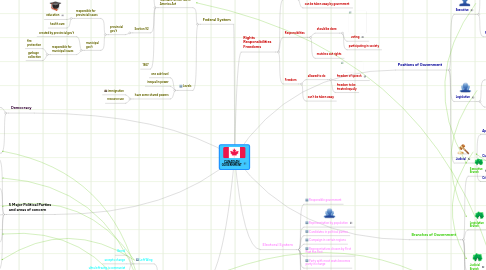
1. Democracy
1.1. Citizens
1.1.1. Values of Citizens
1.1.1.1. have a sense of what is socially just
1.1.1.2. be treated equally
1.1.1.3. have a voice in decision making
1.1.1.4. have rights and freedoms
1.1.1.5. have a sense of responsibility
1.1.2. meets citizenship requirements
1.1.3. acknowledges
1.1.3.1. rights
1.1.3.2. responsibilities
1.2. History
1.2.1. middle of 5th Century BCE
1.2.2. Greece
2. Federal System
2.1. British North America Act
2.1.1. Section 91
2.1.1.1. federal gov't
2.1.1.1.1. responsible for national matters
2.1.1.1.2. has residual powers
2.1.2. Section 92
2.1.2.1. provincial gov't
2.1.2.1.1. responsible for provincial issues
2.1.2.1.2. municipal gov't
2.1.3. 1867
2.2. Levels
2.2.1. one sub-level
2.2.2. inequal in power
2.2.3. have some shared powers
2.2.3.1. immigration
2.2.3.2. resource use
3. Political Spectrum
3.1. Left Wing
3.1.1. liberal
3.1.2. accepts change
3.1.3. ultra left wing is communist
3.2. Center
3.2.1. balance of liberal and conservative
3.2.2. likes change and tradition
3.3. Right Wing
3.3.1. conservative
3.3.2. values tradition
3.3.3. ultra right wing is dictatorship
4. 5 Major Political Parties and areas of concern
4.1. Party
4.1.1. Accommodate Quebec
4.1.2. National healthcare
4.1.3. Defending individual rights
4.2. Party
4.2.1. Accommodate Quebec
4.2.2. Conservative social+economic policies
4.2.3. Use peacekeepers internationally
4.3. Party
4.3.1. Farmers in MB and SK
4.3.2. Urban workers in BC and ON
4.3.3. Support for less fortunate
4.4. Party
4.4.1. Separating Quebec
4.4.2. Independence of French speakers
4.4.3. Represents interests of Quebecers
4.5. Party
4.5.1. Support green economics
4.5.2. Planet is interconnected
4.5.3. Supports progressive social planning
5. Branches of Government
5.1. Executive Branch
5.1.1. has power to administer laws
5.1.2. federal
5.1.2.1. prepare national budget
5.1.3. provincial
5.1.3.1. sets high school diploma requirements
5.1.4. municipal
5.1.4.1. inspect businesses
5.2. Legislative Branch
5.2.1. has power to make and pass laws
5.2.2. federal
5.2.2.1. sets insurance and payment rates
5.2.3. provincial
5.2.3.1. sets tax rate
5.2.4. municipal
5.2.4.1. makes by-laws
5.3. Judicial Branch
5.3.1. has power to decide lawbreakers and punishments
5.3.2. power not held by government
5.3.3. federal and provincial
5.3.3.1. held by judges
5.4. Supported by Canadian citizens
5.5. Roots of Power
5.5.1. BNA Act, 1867
5.5.2. Constitution Act, 1982
5.5.3. Laws and Traditions
6. Positions of Government
6.1. Executive
6.1.1. Federal
6.1.1.1. Queen
6.1.1.1.1. represented by Governor General
6.1.1.2. Prime Minister
6.1.1.3. Cabinet
6.1.1.4. Public Service
6.1.2. Provincial
6.1.2.1. Queen
6.1.2.1.1. represented by Lieutenant Governor
6.1.2.2. Premier
6.1.2.3. Cabinet
6.1.2.4. Public Service
6.2. Legislative
6.2.1. Federal
6.2.1.1. Governor General
6.2.1.2. Senate
6.2.1.2.1. also called Upper House
6.2.1.3. House of Commons
6.2.1.3.1. also called Lower House
6.2.2. Provincial
6.2.2.1. Lieutenant Governor
6.2.2.2. Legislative Assembly
6.2.2.2.1. Members of Provincial Parliament (MPP)
6.2.2.2.2. House of Commons
6.3. Judicial
6.3.1. Appeal
6.3.1.1. Supreme Court of Canada
6.3.1.2. Provincial Supreme Court
6.3.1.3. Court of Appeal
6.3.2. Civil
6.3.2.1. Civil Court
6.3.2.2. Small Claims Court
6.3.2.3. Family Court
6.3.3. Criminal
6.3.3.1. Superior Court
6.3.3.2. Criminal Court
7. Electoral System
7.1. Responsible government
7.2. Representation by population
7.3. Candidates in political parties
7.4. Campaign in certain regions
7.5. Representatives chosen by First Past the Post
7.6. Party with most seats becomes party in charge
7.7. Parliament can be majority, minority or coalition
7.8. Parliament dissolves and electoral system restarts
8. Rights Responsibilities Freedoms
8.1. Rights
8.1.1. allowed to do
8.1.1.1. right to vote
8.1.1.2. right to participate
8.1.2. can be taken away by government
8.2. Responsibilties
8.2.1. should be done
8.2.1.1. voting
8.2.1.2. participating in society
8.2.2. matches out rights
8.3. Freedom
8.3.1. allowed to do
8.3.1.1. freedom of speech
8.3.1.2. freedom to be treated equally
8.3.2. can't be taken away
